What is a vacuum valve for sewage and how to install it
Often, when building a sewage system, builders make a mistake, since they do not provide for its ventilation, especially for inexperienced developers. The consequences of such a slip can result in the appearance of a characteristic unpleasant smell in the house. Solve this problem will help the vacuum valve for sewage, which, in fact, is devoted to this article.

Why do I need a vacuum valve
Many inexperienced craftsmen doubt why a sewage vacuum valve is needed at all, because every sanitary fixture is equipped with a water seal that does not let in any odors?
In fact, the mechanism of the system is more complex than it might seem at first glance:
- When a large amount of water is drained into the toilet, a vacuum occurs inside the system.. As a result, water is absorbed from the water traps. Despite the fact that the suction is partial, it is enough to have an unpleasant smell of sewage in the room.
- Hot water flows into the system regularly, causing vapors to rise.
If there is ventilation in the house, but it is simply clogged, then it can be cleaned. Of course, it’s quite difficult to handle this task with your own hands, but a specialist can quickly solve a problem.
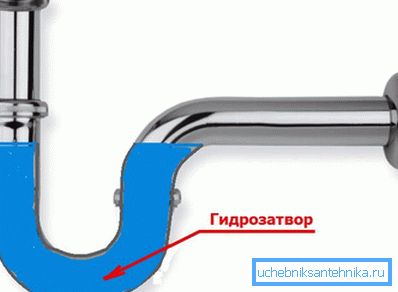
If there is no ventilation in the house, and it is technically expensive or difficult to build, the installation of a vacuum valve is the way out of this situation. It must be said that a special need for this device arises when an automatic washing machine is installed in the house, which discharges water into the system under pressure. Sometimes there are even cases when, after connecting the machine, it becomes necessary to install a second, additional valve.
Valve device and its installation
The principle of operation of the vacuum sewer valve is quite simple. When the drains move along the riser, thereby creating a vacuum, the shut-off element of the valve opens, resulting in air leaks. When the pressure in the system is equalized, the spring returns the valve to its place, as a result of which further movement of gases becomes impossible, respectively, unpleasant odors do not penetrate into the room.

The standard vacuum sewer valve has a plastic housing. The main element of the design is the rod, which raises the lateral outlet. With a decrease in pressure in the system, the rod is lowered, as a result of which the hole closes.
To prevent the stock from rising higher than necessary, a rubber gasket is located above it. It must be said that there are structures in which a rubber membrane is used instead of a rod. Their disadvantage is the rapid deterioration of the membrane, as a result of which it must be regularly replaced.
Tip! The price of vacuum valves with a diaphragm is slightly lower than devices with a stem, however, it is impractical to acquire them because of the rapid failure.
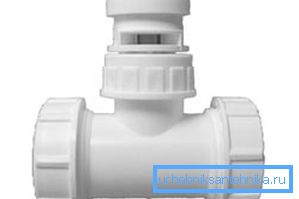
It should be noted that there are two types of vacuum valves:
| Purpose | Diameter of aerator |
| For sinks | 50 mm |
| For a common riser | 110 mm |
Note! The first valve can be used only for a few plumbing fixtures, for example, a sink and a toilet bowl.
The appearance of the devices may vary, in addition there may be minor technical differences, however, the principle of operation and the diameter of the sewer aerators remain the same.
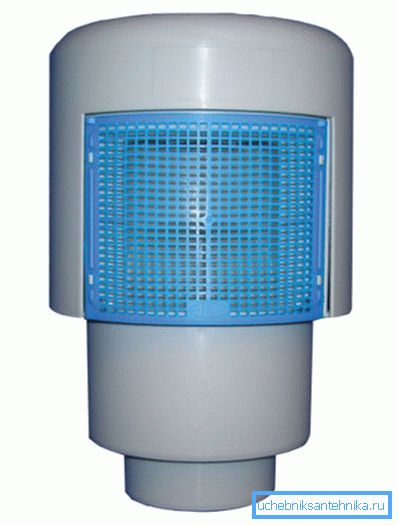
Installation Features
Now consider how to properly install a vacuum valve on the sewer. To perform this operation, it is not necessary to invite a specialist, as every home master can cope with it. However, you must first familiarize yourself with a number of nuances of this operation.
Often, the sewage vacuum valve causes consumers to misunderstand. As a result, many home masters dismantle the upper part of the risers, which rises above the roof, and install this device instead. This should not be done, since the valve does not fully replace the ventilation of the sewage system, unless it is clogged with foreign objects and debris.
Note! This device is allowed to be installed in apartment buildings, however, no higher than the 6th floor. The fact is that there is a possibility of a strong discharge that can occur as a result of the simultaneous descent of sewage from two toilets. Such a load valve can not withstand.
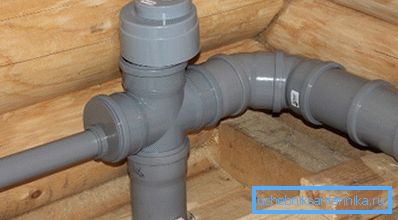
In addition, when installing the device, you should observe the following rules:
- The valve can only be installed in rooms where the air temperature does not fall below zero degrees Celsius. The fact is that in the cold knot will not function. Therefore, it is usually installed in toilets or heated attics.
- If there is a drain in the floor, the valve should be located 30-35 cm above the floor.
- If there is no drain, the aerator should be located 10 cm below the highest sewage outlet.
- In the case of mounting the valve in a box or niche, it is necessary to ensure free air flow to the sky. Otherwise, the device will not work as expected.
Note! From time to time a vacuum valve requires maintenance - replacing rubber gaskets.
As for the installation itself, the instruction is extremely simple - the product is inserted into the free end of the sewer pipe or into a special socket. Of course, the connection should be tight, so you should use a rubber cuff.
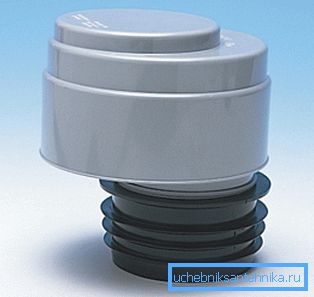
Of course, the decision to install the device must be made by a specialist who has an idea about the features of the sewer system at the facility. However, in any case, its installation will not be superfluous and the operation of the system will not harm.
Conclusion
In some cases, the vacuum valve is the only way to prevent regular breaks in the trap, accompanied by the spread of unpleasant odor in the room. Installation work can be performed independently, the only thing is that you must follow the above rules. The result of this operation will be trouble-free operation of the sewer system.
From the video in this article, you can get more information on this topic.